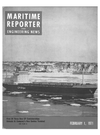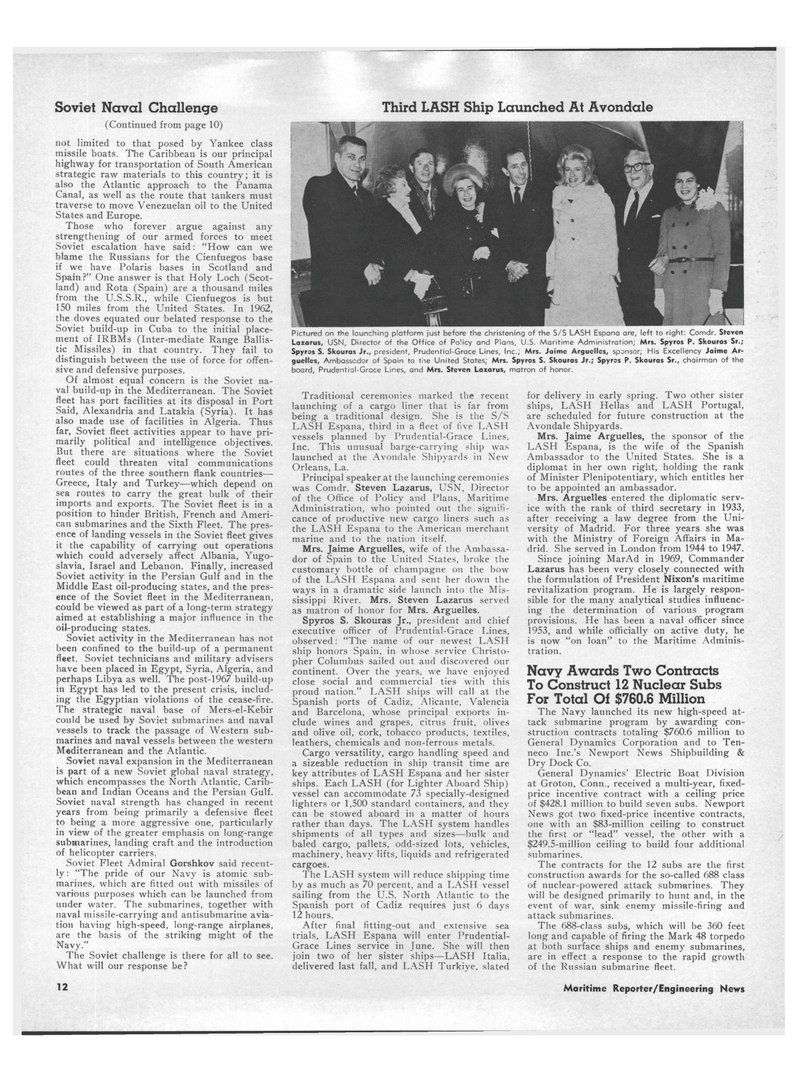
Page 10: of Maritime Reporter Magazine (February 1971)
Read this page in Pdf, Flash or Html5 edition of February 1971 Maritime Reporter Magazine
Third LASH Ship Launched At Avondale
Pictured on the lounching platform just before the christening of the S/S LASH Espana are, left to right: Comdr. Steven
Lazarus, USN, Director of the Office of Policy and Plans, U.S. Maritime Administration; Mrs. Spyros P. Skouras Sr.;
Spyras S. Skouras Jr., president, Prudential-Grace Lines, Inc.; Mrs. Jaime Arguelles, sponsor; His Excellency Jaime Ar- guelles, Ambasscdor of Spain to the United States; Mrs. Spyros S. Skouras Jr.; Spyras P. Skouras Sr., chairman of the board, Prudential-Grace Lines, and Mrs. Steven Lazarus, matron of honor.
Soviet Naval Challenge (Continued from page 10) not limited to that posed by Yankee class missile boats. The Caribbean is our principal highway for transportation of South American strategic raw materials to this country; it is also the Atlantic approach to the Panama
Canal, as well as the route that tankers must traverse to move Venezuelan oil to the United
States and Europe.
Those who forever argue against any strengthening of our armed forces to meet
Soviet escalation have said: "How can we blame the Russians for the Cienfuegos base if we have Polaris bases in Scotland and
Spain?" One answer is that Holy Loch (Scot- land) and Rota (Spain) are a thousand miles from the U.S.S.R., while Cienfuegos is but 150 miles from the United States. In 1962, the doves equated our belated response to the
Soviet build-up in Cuba to the initial place- ment of IRBMs (Inter-mediate Range Ballis- tic Missiles) in that country. They fail to distinguish between the use of force for offen- sive and defensive purposes.
Of almost equal concern is the Soviet na- val build-up in the Mediterranean. The Soviet fleet has port facilities at its disposal in Port
Said, Alexandria and Latakia (Syria). It has also made use of facilities in Algeria. Thus far, Soviet fleet activities appear to have pri- marily political and intelligence objectives.
But there are situations where the Soviet fleet could threaten vital communications routes of the three southern flank countries—
Greece, Italy and Turkey—which depend on sea routes to carry the great bulk of their imports and exports. The Soviet fleet is in a position to hinder British, French and Ameri- can submarines and the Sixth Fleet. The pres- ence of landing vessels in the Soviet fleet gives it the capability of carrying out operations which could adversely affect Albania, Yugo- slavia, Israel and Lebanon. Finally, increased
Soviet activity in the Persian Gulf and in the
Middle East oil-producing states, and the pres- ence of the Soviet fleet in the Mediterranean, could be viewed as part of a long-term strategy aimed at establishing a major influence in the oil-producing states.
Soviet activity in the Mediterranean has not been confined to the build-up of a permanent fleet. Soviet technicians and military advisers have been placed in Egypt, Syria, Algeria, and perhaps Libya as well. The post-1967 build-up in Egypt has led to the present crisis, includ- ing the Egyptian violations of the cease-fire.
The strategic naval base of Mers-el-Kebir could be used by Soviet submarines and naval vessels to track the passage of Western sub- marines and naval vessels between the western
Mediterranean and the Atlantic.
Soviet naval expansion in the Mediterranean is part of a new Soviet global naval strategy, which encompasses the North Atlantic, Carib- bean and Indian Oceans and the Persian Gulf.
Soviet naval strength has changed in recent years from being primarily a defensive fleet to being a more aggressive one, particularly in view of the greater emphasis on long-range submarines, landing craft and the introduction of helicopter carriers.
Soviet Fleet Admiral Gorshkov said recent- ly: "The pride of our Navy is atomic sub- marines, which are fitted out with missiles of various purposes which can be launched from under water. The submarines, together with naval missile-carrying and antisubmarine avia- tion having high-speed, long-range airplanes, are the basis of the striking might of the
Navy."
The Soviet challenge is there for all to see.
What will our response be?
Traditional ceremonies marked the recent launching of a cargo liner that is far from being a traditional design. She is the S/S
LASH Espana, third in a fleet of five LASH vessels planned by Prudential-Grace Lines,
Inc. This unusual barge-carrying ship was launched at the Avondale Shipyards in New
Orleans, La.
Principal speaker at the launching ceremonies was Comdr. Steven Lazarus, USN, Director of the Office of Policy and Plans, Maritime
Administration, who pointed out the signifi- cance of productive new cargo liners such as the LASH Espana to the American merchant marine and to the nation itself.
Mrs. Jaime Arguelles, wife of the Ambassa- dor of Spain to the United States, broke the customary bottle of champagne on the bow of the LASH Espana and sent her down the ways in a dramatic side launch into the Mis- sissippi River. Mrs. Steven Lazarus served as matron of honor for Mrs. Arguelles.
Spyros S. Skouras Jr., president and chief executive officer of Prudential-Grace Lines, observed: "The name of our newest LASH ship honors Spain, in whose service Christo- pher Columbus sailed out and discovered our continent. Over the years, we have enjoyed close social and commercial ties with this proud nation." LASH ships will call at the
Spanish ports of Cadiz, Alicante, Valencia and Barcelona, whose principal exports in- clude wines and grapes, citrus fruit, olives and olive oil, cork, tobacco products, textiles, leathers, chemicals and non-ferrous metals.
Cargo versatility, cargo handling speed and a sizeable reduction in ship transit time are key attributes of LASH Espana and her sister ships. Each LASH (for Lighter Aboard Ship) vessel can accommodate 73 specially-designed lighters or 1,500 standard containers, and they can be stowed aboard in a matter of hours rather than days. The LASH system handles shipments of all types and sizes—bulk and baled cargo, pallets, odd-sized lots, vehicles, machinery, heavy lifts, liquids and refrigerated cargoes.
The LASH system will reduce shipping time by as much as 70 percent, and a LASH vessel sailing from the U.S. North Atlantic to the
Spanish port of Cadiz requires just 6 days 12 hours.
After final fitting-out and extensive sea trials, LASH Espana will enter Prudential-
Grace Lines service in June. She will then join two of her sister ships—LASH Italia, delivered last fall, and LASH Turkiye, slated for delivery in early spring. Two other sister ships, LASH Hellas and LASH Portugal, are scheduled for future construction at the
Avondale Shipyards.
Mrs. Jaime Arguelles, the sponsor of the
LASH Espana, is the wife of the Spanish
Ambassador to the United States. She is a diplomat in her own right, holding the rank of Minister Plenipotentiary, which entitles her to be appointed an ambassador.
Mrs. Arguelles entered the diplomatic serv- ice with the rank of third secretary in 1933, after receiving a law degree from the Uni- versity of Madrid. For three years she was with the Ministry of Foreign Affairs in Ma- drid. She served in London from 1944 to 1947.
Since joining MarAd in 1969, Commander
Lazarus has been very closely connected with the formulation of President Nixon's maritime revitalization program. He is largely respon- sible for the many analytical studies influenc- ing the determination of various program provisions. He has been a naval officer since 1953, and while officially on active duty, he is now "on loan" to the Maritime Adminis- tration.
Navy Awards Two Contracts
To Construct 12 Nuclear Subs
For Total Of $760.6 Million
The Navy launched its new high-speed at- tack submarine program by awarding con- struction contracts totaling $760.6 million to
General Dynamics Corporation and to Ten- neco Inc.'s Newport News Shipbuilding &
Dry Dock Co.
General Dynamics' Electric Boat Division at Groton, Conn., received a multi-year, fixed- price incentive contract with a ceiling price of $428.1 million to build seven subs. Newport
News got two fixed-price incentive contracts, one with an $83-million ceiling to construct the first or "lead" vessel, the other with a $249.5-million ceiling to build four additional submarines.
The contracts for the 12 subs are the first construction awards for the so-called 688 class of nuclear-powered attack submarines. They will be designed primarily to hunt and, in the event of war, sink enemy missile-firing and attack submarines.
The 688-class subs, which will be 360 feet long and capable of firing the Mark 48 torpedo at both surface ships and enemy submarines, are in effect a response to the rapid growth of the Russian submarine fleet. 12 Maritime Reporter/Engineering News

 9
9

 11
11
